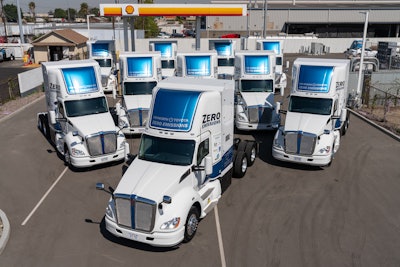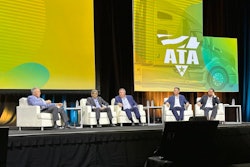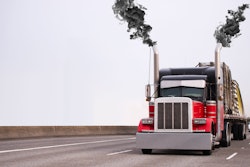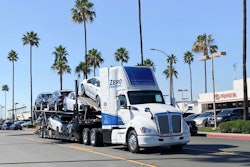
Fueled by billions of dollars in federal funding, hydrogen coalition groups across the U.S. are gaining steam as they aim to help facilitate production of the fuel that’s been mostly confined to California, where fuel cell trucks and cars offer a zero-emission alternative to all-electric.
According to the Department of Energy, all 54 hydrogen stations in the U.S. are located in California, where fuel cell trucks have been busy in pilot programs the past few years at the nation’s busiest ports.
Those trucks and future hydrogen combustion models now stand a better chance of finding work in other regions around the U.S. thanks to heavy federal funding that’s spurring interest in hydrogen production.
[Related: Producing hydrogen on site provides increased flexibility]
New York, Maine, Rhode Island, Connecticut, Massachusetts and New Jersey comprise a multi-state effort that kicked off in late summer to focus on creating a clean hydrogen hub through the Regional Clean Hydrogen Hubs program under the Infrastructure Investment and Jobs Act.
The coalition of six states and now more than 60 clean hydrogen ecosystem partners (Hyzon Motors is currently the only fuel cell truck manufacturer listed) are competing for up to $7 billion in funding from the Department of Energy to help pave the way for producing hydrogen from clean energy sources like hydropower, solar and wind.
The Midwestern Hydrogen Coalition, which includes Illinois, Indiana, Kentucky, Michigan, Minnesota, Ohio and Wisconsin, announced that it’s seeking “the potential development of one or more hydrogen hub applications” and upholds the region as having “the largest hydrogen infrastructure network in the nation in the form of ammonia production, pipelines, and ‘nurse’ tanks, given that ammonia is an ideal hydrogen carrier.”
With hydrogen interest quickly building beyond the West Coast, the California Fuel Cell Partnership announced that it had expanded its reach and changed its name to Hydrogen Fuel Cell Partnership nearly 23 years after the government-industry collaboration was first launched.
“The change in name further enables our members to work across the country to share information, best practices and lessons learned by all of our members,” said Joseph Cappello, chair of the Hydrogen Fuel Cell Partnership and CEO of Iwatani Corporation of America.
Potential impact on trucking
Kenworth, which stands out as one of the nation’s biggest players in fuel cell Class 8, sees these expanding coalitions generating more market interest in fuel cell adoption. Kenworth fuel cell trucks have long been at work in California where air quality concerns rank high for local and state officials.A Kenworth T660 equipped with Toyota fuel cell technology first went to work at Southern California ports in 2017 under Toyota’s Project Portal. The Port of Los Angeles is now piloting ten T680 FCEVs (fuel cell electric vehicles) as part of the $82.5 million “Shore-to-Store” project funded by the California Air Resources Board and project partners.
“It is great organizations are forming to accelerate the adoption of hydrogen fuel cell technology and production,” said Kenworth Chief Engineer Joe Adams. “It has long been a chicken or the egg situation with hydrogen fuel cell vehicles versus fueling stations/production. The more advocacy groups can bring both sides together and coordinate government incentives for the development and adoption of both, the faster each side can release commercially viable products in the marketplace.”
Chevron also welcomes coalition efforts. No stranger to hydrogen partnerships, last week Chevron announced that it had teamed up with hydrogen players Air Liquide, LyondellBasell and Uniper to explore the possible development of a hydrogen and ammonia production facility along the Gulf Coast. Neighboring Interstate 10 provides plenty of truck traffic that could eventually benefit from the facility.
“We believe that as demand for hydrogen increases, both in light-duty and heavy-duty transportation uses but for broader harder-to-decarbonize industries as well, the pace of expansion will continue to accelerate, and will be focused on regions that have a supportive policy framework,” said Chevron spokesperson Creighton Welch.
Morten Holum, CEO, of Hexagon Purus, a provider of hydrogen fuel and distributions systems, pointed out that in addition to the $7 billion set aside to create hydrogen hubs, the nascent zero-emission industry is also getting a big boost from the largest U.S. climate and tax bill to date – the Inflation Reduction Act, which was passed into law in August.
“It aims to reduce carbon emissions by roughly 40% by 2030, and reach net zero carbon emissions in the U.S. by 2050,” Holum explained. “It unlocks $370 billion of funding for clean energy and domestic energy production and includes a hydrogen production tax credit of up to $3.0/kg.”
Marco Wang, research analyst at Interact Analysis, pointed out that hydrogen coalitions have also been at work outside the U.S. helping to promote fuel cell adoption.
“Establishing interregional hydrogen partnerships and coalitions is the current trend to develop the hydrogen industry,” Wang said. “Hydrogen supply systems and infrastructure, especially low carbon hydrogen, have high upfront costs and long ROI cycles. The supply and demand of hydrogen in different regions is likely to be unbalanced.
“Thus, government funding and interregional cooperation are necessary to effectively promote the incubation of the green hydrogen supply chain,” Wang continued. “Europe and China are doing something similar, and industrial alliances are an important means to expand the infrastructure and promote the end-use of hydrogen.”










